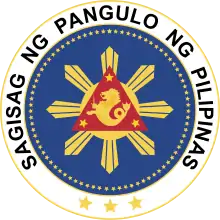Rehabilitation of Marawi
The Rehabilitation of Marawi began following the end of the Battle of Marawi in October 2017 which left the city devastated. The five month-conflict which started in May 2017 saw government forces fighting against ISIL-affiliated militants led by Isnilon Hapilon of the Abu Sayyaf and Omar and Abdullah Maute of the Maute group.

History

Efforts to rehabilitate Marawi began even as the Battle of Marawi was still ongoing. An inter-agency taskforce called Task Force Bangon Marawi was set up on June 28, 2017, to facilitate the rehabilitation after the conflict subsides.[1] The Philippine hosting of the regional 2019 Southeast Asian Games was initially cancelled in August 2017 with government funds meant for the hosting to be reallocated to the rehabilitation efforts. Two months later the government said that the country will remain as hosts.[2]
The Department of Interior and Local Government has announced that the rehabilitation efforts has already begun by October 18, 2017.[3] By October 27, 2017, a few days after the conflict ended, the Armed Forces of the Philippines dissolved its Joint Task Force Marawi which marks the start of full-scale rehabilitation of Marawi. The military set up Joint Task Force Ranao to replace the defunct task force to facilitate the rehabilitation efforts.[4]
The Philippine military started clearing unexploded ordnance after battle and has cleared around 85 percent of the ordnance by May 2018.[5] Around 70 percent of the displaced residents of Marawi has returned to the city by this time.[6]
In 2020, the chair of Task Force Bangon Marawi declared that 20%-30% of Marawi City had been rehabilitated.[7][8] As of November 2020, some 2,800 families remain in temporary shelters.[9][10]
Finances
Projected cost
The National Economic and Development Authority released a projection stating that the necessary investments related to the rehabilitation of Marawi outside the "main battle zone" from 2018 to 2022 will cost around ₱53 billion .[11][12] Task Force Bangon Marawi's estimated cost for the rehabilitation of the whole city is ₱75 to 80 billion as of May 2018.[12]
Budget
The Philippine government has allotted a budget of ₱5 billion for the year 2017.[13] In 2018, the allocated budget is ₱10 billion from the National Disaster Risk Reduction Management Fund and an additional ₱5 billion from the Unprogrammed Appropriations in the 2018 General Appropriations Act.[12]
Foreign aid
Amidst the battle, some countries and international organization either pledged or gave aid for the rehabilitation of Marawi. China on its part gave a ₱15 million check donation[14] as well as shipment of heavy equipment such as excavators, bulldozers, and dump trucks.[15] India donated about Rs 3.2 crore[note 1] for the rehabilitation and relief of Marawi.[17]
The Asian Development Bank and World Bank expressed their willingness in providing technical assistance in regards to the rehabilitation of Marawi.[18]
By October 2017, the Philippine government has received rehabilitation aid from Canada, China, Germany, India, South Korea, Singapore, Thailand. It has also received aid from the United States Agency for International Development and the ASEAN Coordinating Center for Humanitarian Assistance on Management. Australia, Japan, the United States, as well as the European Union and the United Nations Development Program have pledged aid.[4]
Notes
- About ₱25 million or US$500 thousand[16]
References
- Ranada, Pia (3 July 2017). "Duterte creates task force in charge of Marawi rehab". Retrieved 3 July 2017.
- "PH withdraws hosting of 2019 SEA games". ABS-CBN News. 21 July 2017. Retrieved 21 July 2017.
- "Marawi rehabilitation has begun – DILG". The Manila Times. 18 October 2017. Retrieved 28 October 2017.
- Mendez, Christina (28 October 2017). "International community vows aid for Marawi rehab". The Philippine Star. Retrieved 28 October 2017.
- Nepomuceno, Priam (22 May 2018). "85% of unexploded ordnance in Marawi City cleared: AFP spox". Philippine Canadian Inquirer. Retrieved 22 May 2018.
- Corrales, Nestor (22 May 2018). "Palace satisfied with Marawi rehabilitation progress a year after siege". Philippine Daily Inquirer. Retrieved 22 May 2018.
- Ilas, Joyce (November 19, 2020). "Only 20-30% of Marawi rehabilitated three years since deadly siege". CNN. Retrieved 2020-12-04.
- Ramos, Christia Marie (2020-11-19). "30% of Marawi rehab done so far a year before Dec. 2021 deadline". Inquirer. Retrieved 2020-12-04.
- Ramos, Christia Marie (2020-11-19). "2,800 families in Marawi City still in temporary shelters". Inquirer. Retrieved 2020-12-04.
- "Marawi rehabilitation up to 30 pct complete 3 yrs after siege: task force data". ABS-CBN News. 2020-11-19. Retrieved 2020-12-04.
- "P53B needed for Marawi rehab". Malaya Business Insight. 22 May 2018. Retrieved 22 May 2018.
- "Marawi rehab could cost up to ₱80-B - task force official". CNN Philippines. 21 May 2018. Retrieved 22 May 2018.
- "P5 billion earmarked for start of Marawi rehab". ABS-CBN News. 28 October 2017. Retrieved 28 October 2017.
- Ranada, Pia (27 June 2017). "China donates P15M for Marawi rehabilitation". Rappler. Retrieved 28 June 2017.
- "China Gives New Equipment to Philippines for Marawi Recovery". The Diplomat. Retrieved 18 October 2017.
- "India donates P25-M for Marawi rehab". ABS-CBN News. Retrieved 13 July 2017.
- Chaudhury, Dipanjan Roy (13 July 2017). "India expands counter terror coop with Philippines in ongoing Fight Against ISIS". ET Bureau. Retrieved 13 July 2017.
- "ADB, World Bank eye technical assistance grants for Marawi rehab". Philippine Daily Inquirer. 13 July 2017. Retrieved 13 July 2017.


